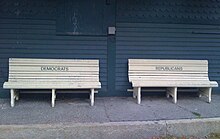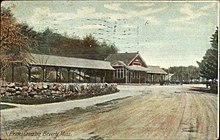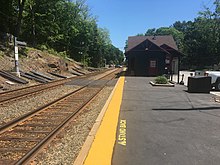Prides Crossing station
Prides Crossing | |||||||||||
|---|---|---|---|---|---|---|---|---|---|---|---|
Gloucester Branch | |||||||||||
| Platforms | 1 side platform | ||||||||||
| Tracks | 2 | ||||||||||
| Construction | |||||||||||
| Accessible | No | ||||||||||
| Other information | |||||||||||
| Fare zone | 5[1] | ||||||||||
| History | |||||||||||
| Opened | c. 1850s | ||||||||||
| Closed | December 14, 2020 | ||||||||||
| Rebuilt | c. 1879 | ||||||||||
| Passengers | |||||||||||
| 2018 | 15 (weekday average boardings)[2] | ||||||||||
| Former services | |||||||||||
| |||||||||||
Prides Crossing station is a former
Station design

Prides Crossing station was located in the village of Prides Crossing, just west of the
The former station building, a one-story stick style structure now occupied by a private business, is located on the south side of the tracks adjacent to the platform. The original canopies have been cut back and enclosed for additional space, and the main building modified as well.[5][6] On the street side of the station building are two benches labeled "Democrats" and "Republicans", which have been local landmarks for decades.[7] In 2015, the well-worn original benches were auctioned for charity and replaced with replicas.[8]
History
Early history

In March 1845, the
A wooden station building – the "tiniest" of the stations in Beverly – was built in 1879 or 1880.
The Eastern Railroad became part of the Boston and Maine Railroad (B&M) in 1885.[9] Not until the early 20th century did the station appear in public timetables.[13] The interior woodwork was damaged by a fire on November 12, 1903.[24] In 1915, Moore proposed to fund a new stone station – provided that it was renamed "Moores Crossing".[25] Between 1924 and 1926, service to the station was reduced from 18 inbound and 16 outbound trains to 6 in each direction, which led to nearby estate owners having difficulty retaining domestic workers.[26] Part of the canopy was removed in the 1940s.[13]
MBTA era

The B&M sold or leased many disused station buildings in the mid-20th century. The station building at Prides Crossing was converted to an ice cream parlor by 1962, and to a general store by 1968.[27][28] The Massachusetts Bay Transportation Authority (MBTA) was formed in 1964 to subsidize suburban commuter rail service. On January 18, 1965, the MBTA began subsidizing some B&M service, including as far as Manchester on the Gloucester Branch.[29] The MBTA bought most B&M commuter rail assets, including the Gloucester Branch, on December 27, 1976.[29] Weekend and midday service to Prides Crossing was ended on February 1, 1981, due to budget cuts, leaving the station with only limited peak-hour service.[30] However, peak-hour express trains for the wealthy North Shore communities, which made only one stop between Prides Crossing and Boston, lasted into the 1980s.[12][31]
On August 11, 1981, a westbound

On January 20, 1984, the North Station approach trestles were destroyed by a fire. Gloucester Branch trains were terminated at a temporary station near Sullivan Square or bussed from Lynn. On November 16, 1984, the Beverly Draw bridge connecting Salem to Beverly burned, cutting off the Rockport Branch and the Ipswich Line from the rest of the system. (All lines running north and west from the Ipswich Line were abandoned by 1984, leaving no route to move equipment to the rest of the system.) A shuttle train was run from Rockport to Beverly Depot until January 7, 1985, when it was replaced by bus service.[29] The locomotives used were then trucked to Danvers so they could be repaired at the MBTA's main maintenance facility. Most of the stations on the cut-off sections were upgraded with accessible mini-high platforms during the closure; due to its low ridership, Prides Crossing was not upgraded.[35] A new bridge opened on December 1, 1985, reconnecting the lines to the larger system.[29]
Closure
With just 15 daily boardings by a 2018 count, Prides Crossing was the third-lowest-ridership station on the MBTA Commuter Rail system, ahead of only Plimptonville station and Silver Hill station.[2] By that time, the station was served by only three peak-hour inbound trips and five peak-hour outbound trips out of fifteen weekday round trips operated on the Gloucester Branch; weekend service did not stop at the station.[1] In November 2020, as part of service cuts during the COVID-19 pandemic, the MBTA proposed to close Prides Crossing and five other low-ridership stations. Prides Crossing was nominated for closure because of its low ridership and lack of accessibility; the accessible Beverly Farms station is just 0.7 miles (1.1 km) to the east.[3][36]
On December 14, reduced schedules went into effect due to limited employee availability.[37] Based on the existing weekend service, these temporary schedules did not include service to Prides Crossing.[38] That day, the MBTA Board voted to enact a more limited set of cuts, including indefinitely closing Prides Crossing and four of the other five stations.[39][40] The closure of the five stations became indefinite effective April 5, 2021.[41]
References
- ^ a b "NEWBURYPORT/ROCKPORT LINE effective November 20, 2017" (PDF). Massachusetts Bay Transportation Authority. November 20, 2017. Archived from the original (PDF) on February 6, 2021.
- ^ a b Central Transportation Planning Staff (2019). "2018 Commuter Rail Counts". Massachusetts Bay Transportation Authority.
- ^ a b Held, Patrick R. (2010). "Massachusetts Bay Colony Railroad Track Charts" (PDF). Johns Hopkins Association for Computing Machinery. p. 22. Archived from the original (PDF) on 8 October 2013.
- ^ "Ridership and Service Statistics" (PDF) (14th ed.). Massachusetts Bay Transportation Authority. 2014.
- ^ ISBN 9780942147087.
- ^ a b "MHC Reconnaissance Survey Town Report: Beverly" (PDF). Massachusetts Historical Commission. 1986. p. 18.
- ISBN 9780738538754.
- ^ "BFIS Donates New "Republican" and "Democrat" Benches at Train Station" (PDF). The Farms Flyer. 20. Beverly Farms Improvement Society. Summer 2015.
- ^ ISBN 9780685412947.
- ^ Bragdon, Joseph H. (1857). Seaboard towns; or, Traveller's guide book from Boston to Portland. Moulton & Clark. p. 186 – via Internet Archive.
- ^ Historical markers erected by Massachusetts Bay Colony Tercentenary Commission. Commonwealth of Massachusetts. 1930. p. 10 – via Internet Archive.
- ^ ISBN 9780831766078.
- ^ a b c M. Hepler (March 20, 1993). "Form B – Building". Massachusetts Historical Commission – via Massachusetts Cultural Resource Information System.
- ISBN 9780738573588.
- ^ "One train stop to be restored". Boston Globe. January 15, 1927. p. 10 – via Newspapers.com.
- ^ "Memoir of Augustus Peabody Loring, Jr". Transactions of The Colonial Society of Massachusetts. Vol. 42. Colonial Society of Massachusetts. February 1952. p. 7.
- ^ "Arrive in Private Car". Boston Globe. July 11, 1909. p. 4 – via Newspapers.com.
- ^ "How the Fricks Traveled: The Westmoreland". The Frick Pittsburgh. January 9, 2020.
- ^ Pulsifer, Holly. "A Glimpse of Life Well-Lived". Drivers Digest.
- hdl:2452/206025.
- ^ Sanborn Fire Insurance Map from Beverly, Essex County, Massachusetts. Sanborn Map Company. 1958. p. 43.
- ^ "Beverly". Boston Globe. April 14, 1996. p. 213 – via Newspapers.com.
- ^ "Real Estate". Boston Globe. April 30, 2000. p. 207 – via Newspapers.com.
- ^ "Railway Station Damaged". Boston Globe. November 13, 1903. p. 13 – via Newspapers.com.
- ^ "Prides Crossing Offer Discussed". Boston Globe. February 7, 1915. p. 17 – via Newspapers.com.

- ^ "Want Train Stops Retained". Boston Globe. November 9, 1926. p. 17 – via Newspapers.com.
- ^ "Few Trains, But Stations Still Busy". Boston Globe. February 16, 1962. p. 24 – via Newspapers.com.
- ^ O'Connell, Richard W. (August 18, 1968). "Old railroad depots take on new careers". Boston Globe. p. A-1 – via Newspapers.com.
- ^ a b c d Belcher, Jonathan. "Changes to Transit Service in the MBTA district" (PDF). Boston Street Railway Association.
- ^ "T changes start today". Boston Globe. February 1, 1981. p. 24 – via Newspapers.com.

- ^ Eastern Line and Gloucester Branch, Massachusetts Bay Transportation Authority, May 3, 1981 – via Wikimedia Commons
- ^ Tlumacki, John (August 11, 1981). "John Tlumacki". Boston Globe. p. 13. Retrieved January 27, 2016.
- ^ Clendinen, Dudley (August 12, 1981). "3 Men Killed in Collision of Massachusetts Trains". New York Times.
- ^ "Railroad Accident Report RAR-82-01: Head On Collision of Boston & Maine Corp Extra 1731 East & MBTA Train No. 570 on Former Boston & Maine Corp. Tracks". National Transportation Safety Board. March 9, 1982.
- ^ Richard, Ray (September 16, 1985). "North Shore bridge job 'on target'". Boston Globe. p. 17, 20 – via Newspapers.com.

- ^ Paget-Seekins, Laurel; Benesh, Kat (November 9, 2020). "Forging Ahead: Scenario and Service Planning" (PDF). Massachusetts Bay Transportation Authority. p. 21.
- ^ "Commuter Rail to Temporarily Operate Reduced Service Schedule Starting December 14" (Press release). Massachusetts Bay Transportation Authority. December 10, 2021.
- ^ "2020/2021 Reduced Service Schedule: Newburyport/Rockport Line" (PDF). Massachusetts Bay Transportation Authority. December 14, 2020. Archived from the original (PDF) on December 10, 2020.
- ^ Enwemeka, Zeninjor (December 14, 2020). "MBTA Control Board Votes To Scale Back Bus, Train And Ferry Service". WBUR. Retrieved February 5, 2021.
- ^ Paget-Seekins, Laurel; Benesh, Kat (December 14, 2020). "Forging Ahead: Service Proposal" (PDF). Massachusetts Bay Transportation Authority. p. 17.
- ^ "Spring 2021 Service Changes". Massachusetts Bay Transportation Authority. February 2021. Archived from the original on February 28, 2021. Retrieved February 28, 2021.
External links
- MBTA – Prides Crossing
- Prides Crossing Confections (Occupants of station building)
- Station on Google Maps Street View
